Scorsese Master Class: Dancing Scorsese film strip

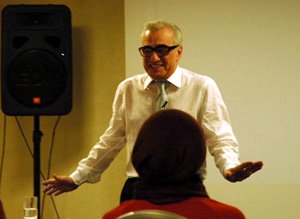



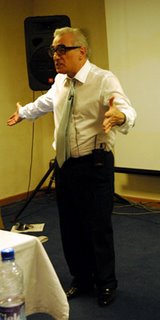

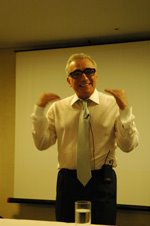

 We thank Scorsese not only for the time he spent with us, but also for acting in one of the filmmaker shorts about cell phones. Mr. Scorsese was subjected to a cell phone ringing in the middle of the class. And no one seemed to know where it was. Everyone looked around guiltily and accusingly at the same time. But no one moved to turn the phone off. Finally it stopped. The class resumed. At the end of the class, Ahmad Kiarostami stood up and thanked Mr. Scorsese for an oscar-winning performance. But he didn't even know it was happening! That's the point as we learned from both filmmakers. Non-actors who play themselves are the best actors, as long as you're a good caster. As Scorsese told us during the class, in Raging Bull all of the handlers were Jake Lamotta's original handlers. No one could play them better than themselves.
We thank Scorsese not only for the time he spent with us, but also for acting in one of the filmmaker shorts about cell phones. Mr. Scorsese was subjected to a cell phone ringing in the middle of the class. And no one seemed to know where it was. Everyone looked around guiltily and accusingly at the same time. But no one moved to turn the phone off. Finally it stopped. The class resumed. At the end of the class, Ahmad Kiarostami stood up and thanked Mr. Scorsese for an oscar-winning performance. But he didn't even know it was happening! That's the point as we learned from both filmmakers. Non-actors who play themselves are the best actors, as long as you're a good caster. As Scorsese told us during the class, in Raging Bull all of the handlers were Jake Lamotta's original handlers. No one could play them better than themselves. Martin Scorsese gave a master class that spanned the topics of the history of cinema, editing, sound, directing actors and non-actors, screenwriting, and even special effects. Mr. Scorsese brought in his original storyboard for the final fight scene in raging bull, which he drew himself. He identified the feeling in the drawings as impetus for the emotion in a scene. It was conveyed even if he wasn't a master draftsman, and his cameraman could read the intention in the drawings. He was sensitive to the effect to the extent that such a difference was felt even in the weight of the pencil with which he drew. All of his storyboards used to be thick and dark, and dramatic, but now the pencil company has started to water-down the lead and it no longer gives the same effect. After all the information and techniques passed on to us, the anecdotes, laughs and even scenes we saw, it’s amazing to think he was really only there for three and a half hours.
Mr. Scorsese commands respect for his commitment to seeing contemporary international films, and for bringing foreign and classic film to the attention of American audiences for the first time through his “Journeys Through Cinema” and through “Martin Scorsese Presents…” At the festival Scorsese programmed “Transes,” a film about the Moroccan band Nas el Ghiwane. Among other international and independent films he spoke of, Scorsese took some time today to speak about “ABC Africa,” a joint film by Abbas Kiarostami and Seifollah Samadian, shot for United Nations' Intl. Fund for Agricultural Development.
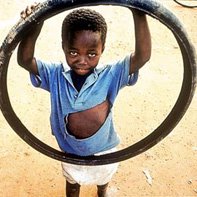
“It was the best film that I saw spanning two years,” he said. “In experiencing the film with the filmmakers, and through the digital camera, you live it with them and they don’t get in the way.
“The images allow you to think… not even to think, but to feel. TV is an unfeeling medium. When you turn on the news, even the news about New Orleans, its all a show. People get inured to it. ‘ABC Africa’ isn’t a show, the filmmakers are there in every sense.”
Scorsese also spoke about the widening difference between independent and Hollywood films. Taxi Driver was an underdog script; they never foresaw it having the impact it did and thus made it for their own pleasure. But smaller films could still have wide distribution in those days. Scorsese remarked on the difference in filmmaking climate between filming “Goodfellas” and “Gangs of New York” by saying, “I always try to make large pictures that will reach a large audience, but that still have the personal element like an independent film. In the ‘70s that was possible. It is much harder now.”

Of “Raging Bull” Scorsese talked at length of the shots and formal decisions. He said that he decided he had to do it in black and white because, he said, “Can you imagine the red of those gloves? How could you take the film seriously? It also gives the film the sense of a tabloid newspaper.”
But like every great artist, left us with mysteries and questions that perhaps even he did not know the answers to, particularly on the sound in the film: “Frank Warner, the sound editor, did a great thing. He got sounds from animals for the ring when everything is happening in slow motion: elephants, tigers and some sounds of which he never revealed the sources. The effect is subtle and yet tremendous.”
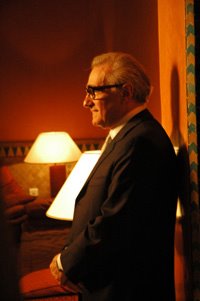

0 Comments:
Post a Comment
<< Home